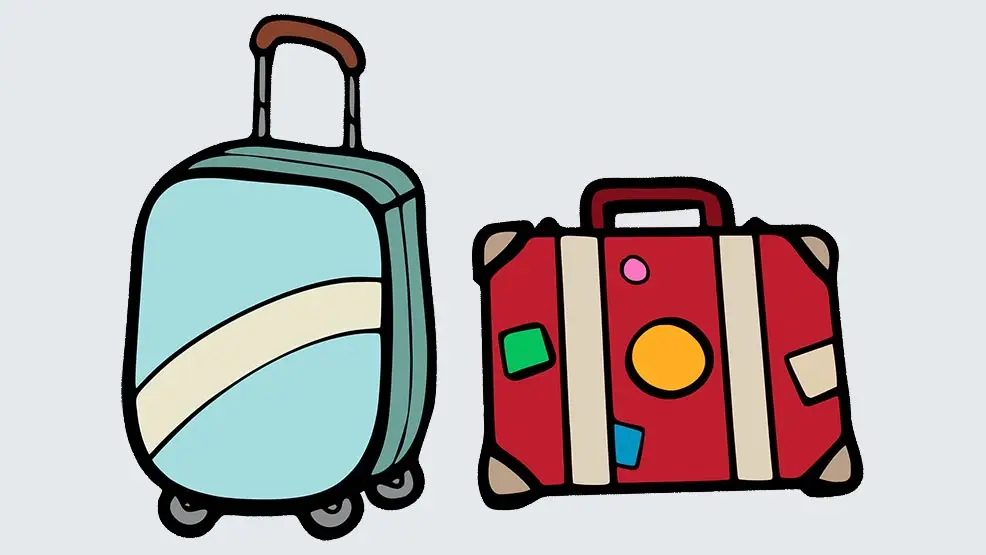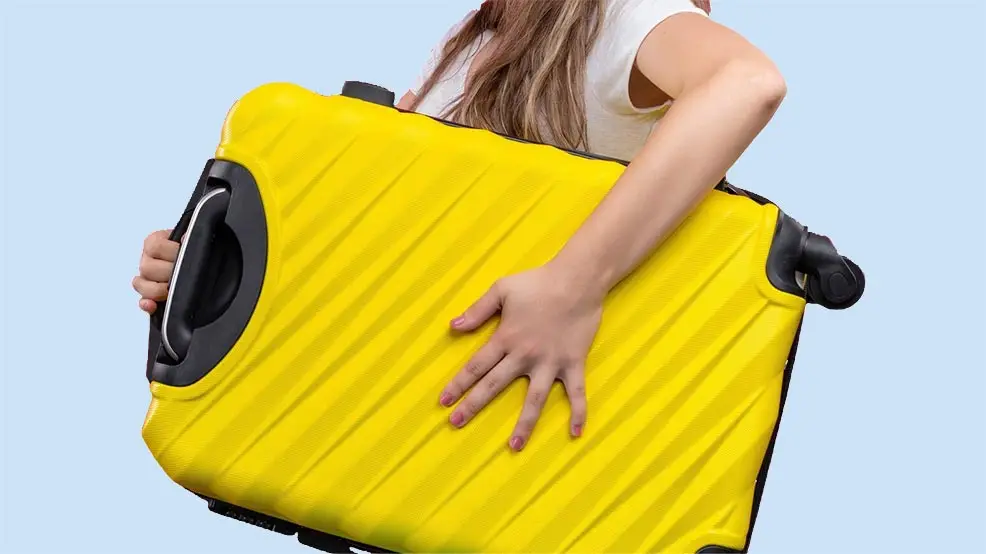Hard shell or soft case? Which type of luggage is best to take on board the aircraft as carry-on?
These questions cannot be answered in general terms. All types of luggage have their advantages and disadvantages. Most importantly, you should be able to stow your carry-on luggage safely and transport it conveniently.

Luggage Type and Empty Weight
The type of luggage you choose for your carry-on or cabin baggage depends on the nature of your trip and ultimately remains a personal decision. As long as you stay within the maximum dimensions and weight limits for carry-on luggage, anything from a plastic bag to a leather suitcase is possible. Airlines don’t have any specific rules about the type of luggage.
For airlines that strictly limit the maximum weight of carry-on luggage to only 5 or 7 kg, you must be very mindful of weight when packing a trolley case. Most trolley cases already have an empty weight of over 2 kg, with hard shells often weighing over 3 kg. Especially if you’re traveling with carry-on luggage only, you’ll need to be very selective with clothing and shoes.
In this case, bags or backpacks made of lightweight but durable material are more suitable. Since these don’t have wheels and extendable handles, they are usually considerably lighter. This allows you to pack an extra pair of shoes in your carry-on.
For business travelers, garment bags are an excellent alternative. They allow you to transport your suit or outfit for meetings safely and largely wrinkle-free to your destination. Many airlines have different maximum dimensions for garment bags, typically 57 x 54 x 15 cm, to be stored in the aircraft cabin as carry-on luggage. Separate compartments often allow for storage of shoes or office documents.
Carry-on Suitcases and Trolleys
Highly popular and practical are the widely offered trolleys, small suitcases with wheels that can be easily pulled behind you. Meanwhile, there are also carry-on versions with four wheels that can rotate 360 degrees, making maneuvering with the suitcase easier.
Trolleys or carry-on suitcases are available in hard or soft variants. Both versions are stable enough to protect the carry-on luggage.
For the hard variant, usually plastic, less commonly aluminum, is used. Polycarbonate or ABS are the most frequently used plastic materials, both of which are very durable. Polycarbonate is somewhat lighter than ABS, but also often a bit more expensive. There are quality differences in suitcases made from both polycarbonate and ABS, as both materials can be of low or high quality. Very cheap suitcases are unfortunately often made of inferior plastic that tends to tear.
For soft carry-on suitcases, textile fabrics made of polyester or nylon are normally used. There isn’t really a significant quality difference between the two; it’s more about the material thickness used for the suitcase.
Whether to choose a hard-shell or soft-shell suitcase is more of a personal decision. Both variants are stable and durable, at least if you choose good quality. Hard plastic material may protect the contents of the suitcase somewhat better against pressure. Weight, on the other hand, no longer plays a major role – the plastic variants are now as light as textile suitcases.

Backpack or Bag
The advantage of a backpack or bag over a trolley is usually the weight. Bags and backpacks are often made of robust yet lightweight fabric. Additionally, the weight of wheels and frame is eliminated.
But every advantage has its disadvantage. Without a frame and wheels, the bag cannot be pulled but must be carried. Even a few kilos of carry-on luggage can become heavy over longer distances.
Backpacks and bags come in different materials. Leather is not used as often anymore; today, textile is typically used. Polyester or nylon are lightweight, durable, and often water and dirt-repellent, making them perfect materials for travel luggage.
Practical Accessories for Carry-on Luggage
Due to all the regulations surrounding carry-on luggage, you now have to carefully check the luggage that goes on board the aircraft.
A few things have proven to be quite practical. You should definitely check the dimensions and weight of your luggage item before departure. Most people will have a way to measure at home, but checking the weight becomes more difficult. Normal personal scales are often not accurate enough for carry-on luggage.
For weighing luggage, there are very practical small digital scales where you can hang the luggage item and see the weight displayed when lifted. These can also be easily taken along, so that nothing goes wrong on the return flight and the carry-on luggage passes through security and onto the plane without problems.
Especially when traveling with carry-on luggage only, transparent bags for liquids are essential, as toothpaste and shampoo also fall under the liquids regulation. If you want to use the bag as a toiletry bag for your bathroom items, it’s worth getting a more stable version that will survive a second vacation.
A type of document folder for all papers has also proven to be very practical. Travel passport, flight ticket, boarding passes, credit cards, and money can be stored here and stowed in your carry-on luggage. This way, you have everything readily available and avoid rummaging around in your bag during one of the many security checks at the airport.
To make a long-haul flight a bit more comfortable, items such as a pillow or earplugs are very helpful. Practical accessories for well-being can be found conveniently in our blog.
